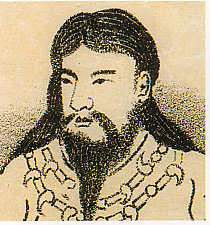Emperor Kaika
| Kaika | |
|---|---|
| Emperor of Japan | |
 | |
| Reign | legendary |
| Predecessor | Kōgen |
| Successor | Sujin |
| Born | legendary |
| Died | legendary |
| Burial | Kasuga no Izakawa no sak no e no misasagi (Nara) |
Emperor Kaika (開化天皇, Kaika-tennō) is the 9th emperor of Japan,[1] according to the traditional order of succession.[2] Historians consider Emperor Kaika to be a legendary person;[3] and the name Kaika-tennō was created for him posthumously by later generations.
No certain dates can be assigned to the emperor's life or reign.[4] The conventionally accepted names and sequence of the early emperors were not to be confirmed as "traditional" until the reign of Emperor Kammu, who was the 50th monarch of the Yamato dynasty.[5]
The Gukanshō records that Kaika ruled from the palace of Isakawa-no-miya at Kasuga in what will come to be known as Yamato province.[6]
Traditional history[change | change source]
Kaika is almost certainly a legend. The Kojiki records only his name and genealogy. The Nihonshoki includes Kaika as the eighth of "eight undocumented monarchs" (欠史八代,, Kesshi-hachidai).[7]
Kaika was the second son of Emperor Kōgen.[6]
Some scholars question the existence of the first nine emperors. These critics consider Kōgen's son (Suijin) to be the earliest to have actually existed.[8]
Events of Kaika's life[change | change source]

The absence of information about Kaika does not imply that no such person ever existed. Very little information is available for study prior to the reign of the 29th monarch, Emperor Kimmei.[9]
After his death[change | change source]
This emperor's official name after his death (his posthumous name) was regularized many centuries after the lifetime which was ascribed to Kaika.[7]
The actual site of his grave is not known. According to the Imperial Household Agency, this emperor is venerated at a memorial Shinto shrine (misasagi) in Nara.[1]
Related pages[change | change source]
References[change | change source]

- ↑ 1.0 1.1 Imperial Household Agency (Kunaichō), 開化天皇 (9); retrieved 2011-10-19.
- ↑ Titsingh, Isaac. (1834). Annales des empereurs du japon, pp. 6-7; Brown, Delmer et al. (1979). Gukanshō, p. 252; Varley, Paul. (1980). Jinnō Shōtōki, p. 93; Nussbaum, Louis-Frédéric et al. (2002). "Traditional order of Tennō" in Japan encyclopedia, pp. 962-963.
- ↑ Kelly, Charles F. "Kofun Culture," Japanese Archaeology. April 27, 2009; retrieved 2011-10-19.
- ↑ Ponsonby-Fane, Richard. (1959). The Imperial House of Japan, p. 30.
- ↑ Aston, William George. (1896). Nihongi, pp. 109.
- ↑ 6.0 6.1 Brown, p. 252.
- ↑ 7.0 7.1 Aston, William George. (1896). Nihongi: Chronicles of Japan from the Earliest Times to A.D. 697. London: Kegan Paul, Trench, Trubner. OCLC 448337491
- ↑ "Life in the Cloudy Imperial Fishbowl," Japan Times. March 27, 2007; retrieved 2011-10-19.
- ↑ Titsingh, pp. 34-36; Brown, pp. 261-262; Varley, pp. 123-124.
Other websites[change | change source]
![]() Media related to Emperor Kaika at Wikimedia Commons
Media related to Emperor Kaika at Wikimedia Commons
| Preceded by Emperor Kōgen |
Legendary Emperor of Japan Kaika 157-98 BC |
Succeeded by Emperor Sujin |
